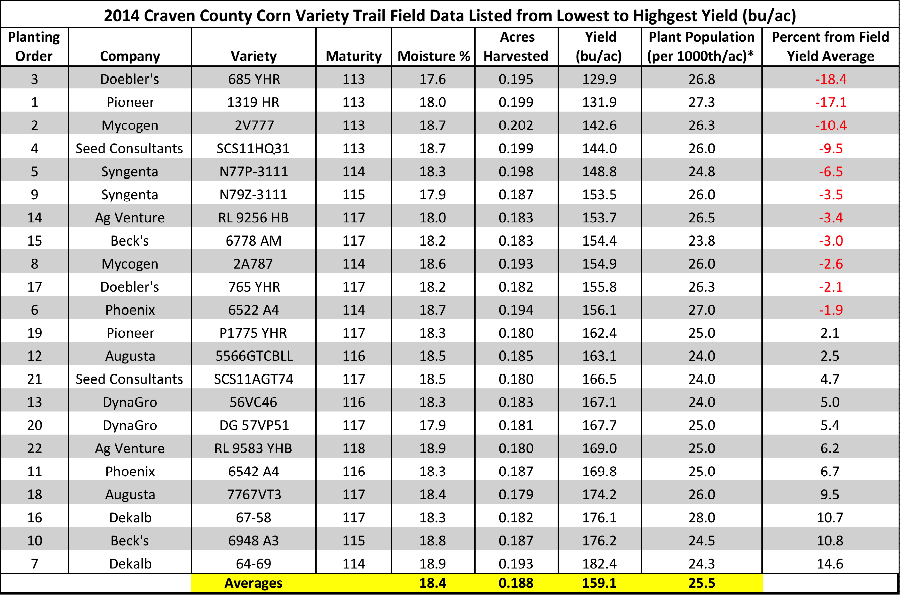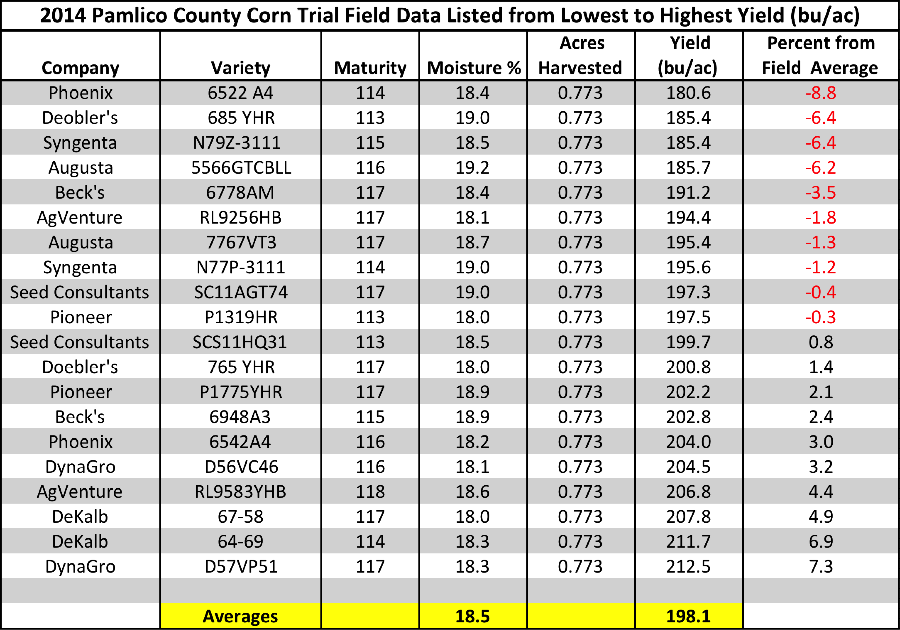By Mike Carroll
In 2014 Craven County participated in the field trials coordinated by NC Cooperative Extension Agents across Eastern NC to evaluate corn yield of specific varieties. Twenty different varieties were selected for planting at fourteen sites across Eastern NC. Data from these sites will be pooled to provide corn producers the opportunity to review varietal performance. Additionally, each county trial may provide additional insight regarding performance since soil types and weather may differ at each location.
Field data for the Craven County site is below. Production at this site involved variable rate application of lime, phosphorous and potassium prior to planting based upon GPS soil sample results . Approximately 26 lbs/ac of actual nitrogen and phosphorous were applied at planting by banding a liquid fertilizer in a 2 X 2 placement to the seed. All varieties were planted at 30,000 seeds per acre into a 30-inch row spacing following the use of rip-strip till tillage equipment. The crop preceding corn was soybean. The soil series for the site is mapped as Norfolk.
The plot was planted on April 11, 2013. Temperature following planting was normal but rainfall was frequent. In fact, within two weeks of planting, average monthly rainfall was exceeded. Above average rainfall continued throughout the season with the exception of about two weeks in mid to late-May when high temperatures and low rainfall stressed plants. (Excessive rainfall of 4-7” above normal monthly rainfall may have also contributed stress to plants during the season.) Raw field data shows the average plot corn yielded 159.1 bu/ac. The lowest corn yield was 129.9 bu/ac and the highest 182.4 bu/ac. (No adjustments for test weight or moisture content).

Any inference of data should reflect the above conditions and weather. Furthermore, pooled data and statistical analysis of this data will provide more valuable data. Until this data is available, comparison of a similar test in the adjacent county of Pamlico is helpful. Climate and corn management between the two counties is similar but corn yield in Pamlico County has historically been higher than that of Craven County due to more productive soil types.
Examination of data from both trials reveals that Dekalb 64-69 and Dekalb 67-58 appear within the top five varieties in both trails. This presents strong evidence of the suitability of these varieties within this area. However, given the relative size of each subplot, variance in soil types within fields, potential border effects, planting order or simply chance, one should extend this concept beyond the “top five highest yielding varieties”. It seems fair to extend evaluation to the top eight varieties simply to allow for such variances within the fields. Doing so, adds AgVenture RL 9583 YHB, Phoenix 6542 A4, DynaGro 56VC46, DynaGro 57VP51, and Beck’s 6948 A3 to the list of top performing varieties at both the Craven and Pamlico locations.

In fairness of evaluation, consideration should allow for the fact that the testing rate of 30,000 seeds per acre may negatively impact varieties with lesser ear flex. Simply put, some varieties may perform better at a much higher plant population than tested in this plot. Other considerations in varietal selection should include varietal test weight, disease resistance, technology traits and date of maturity. Such information is available within data from NCSU Official Variety Test site.
Source : ncsu.edu